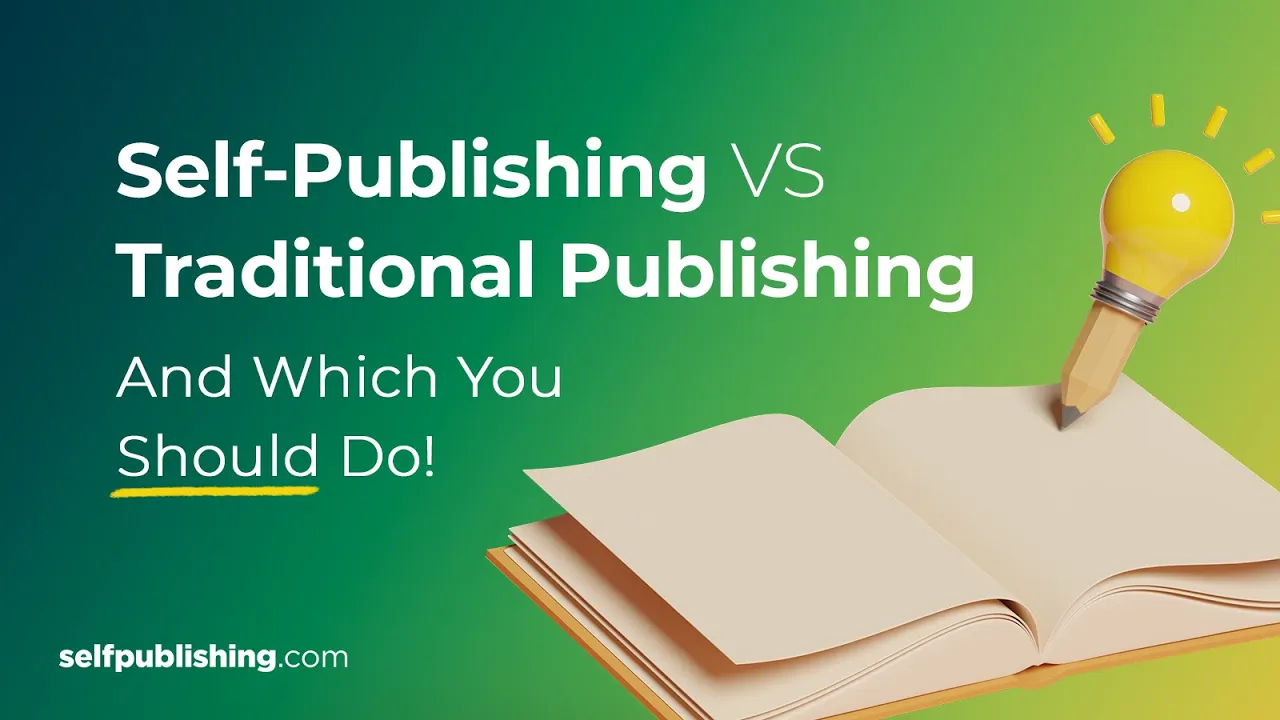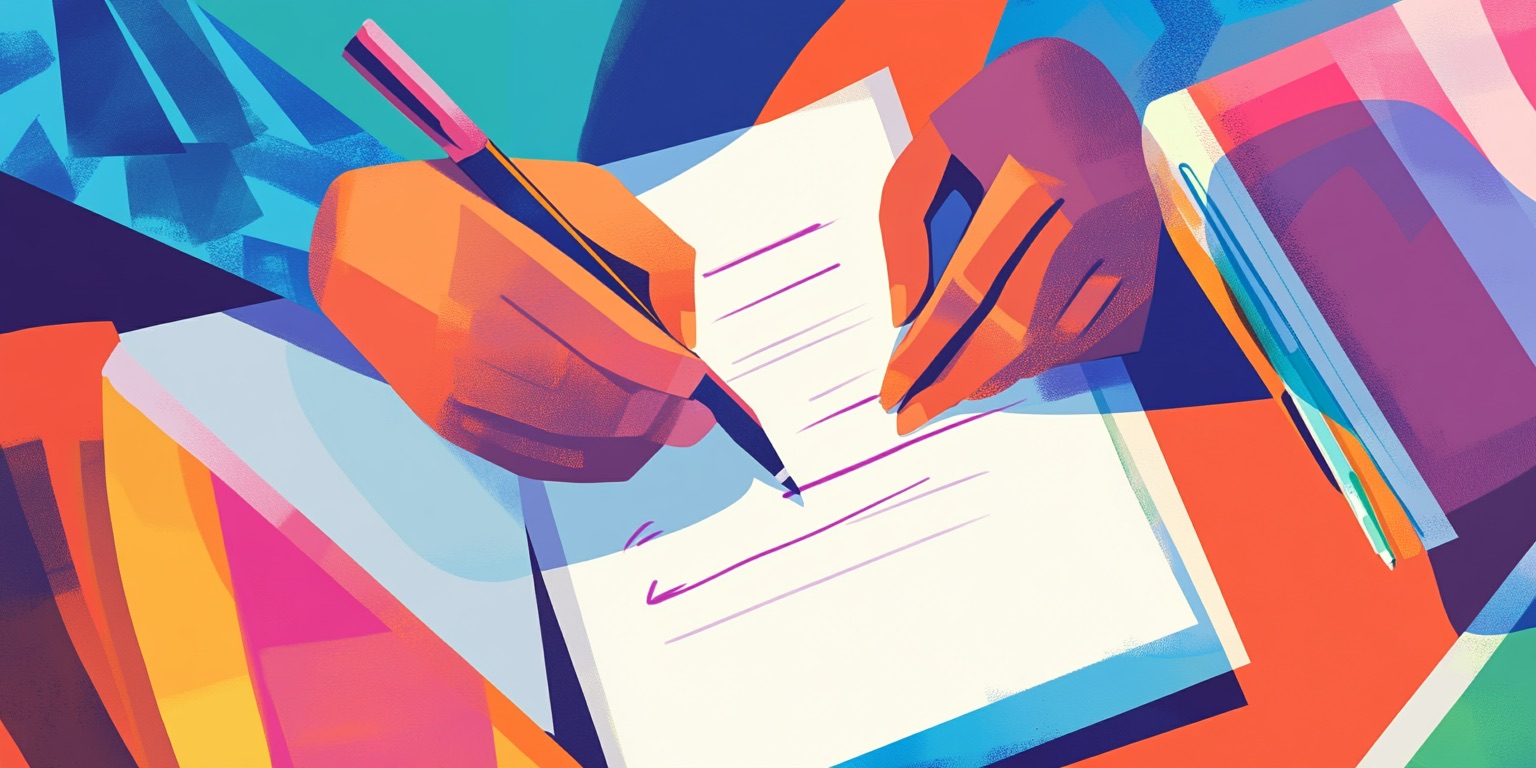Deciding between self-publishing vs traditional publishing is the big choice many authors are faced with in today’s book publishing space.
If you’re researching how to publish a book, you’ve likely started (or finished!) writing your book.
First off, congrats! Wherever you may be on your book-writing journey, you’re well on your way to becoming a published author.
Although you may be stressing over which publishing method is right for you, having options as an author is a good problem to have!
We live in an exciting time when publishing a book has never been easier – and this is true whether you’re writing a nonfiction book, a fiction novel, a memoir, or a children’s book!
In our age of information, it’s as important as ever to make an informed decision between self-publishing vs traditional publishing. A book is life-changing, so you’ll want to be sure you choose the path that’s right for you.
Modern authors have two choices for publishing: self-publishing vs traditional publishing.
So, what’s the difference? In this article, we will go over the definitions of self-publishing vs traditional publishing and the pros and cons of both options so you know how you want to publish your book.
What is self-publishing vs traditional publishing?
Self-publishing a book is the same thing as independently publishing. In brief, self-publishing vs traditional publishing means that an author is in charge of the entire book publishing process – there isn’t a gatekeeper to get approval from!
Although the author oversees and funds the self-publishing process, it shouldn’t be completely DIY. In fact, successful self-published authors hire professionals for things like book editing and book designing, while retaining full creative control.
Because of today’s technology, self-publishing a book is a viable option for many authors.
Traditional publishing, on the other hand, means getting a literary agent and working with the editors at a big publishing house to turn out a book that the company wants to take ownership of. This means you will have less creative control over your book. But there is nothing wrong with traditional publishing, in fact it was the way the publishing industry worked for a long time!
The publishing process explained
To understand whether you want to go with self-publishing vs traditional publishing, let’s take a look at how the writing and publishing process differs between the two.
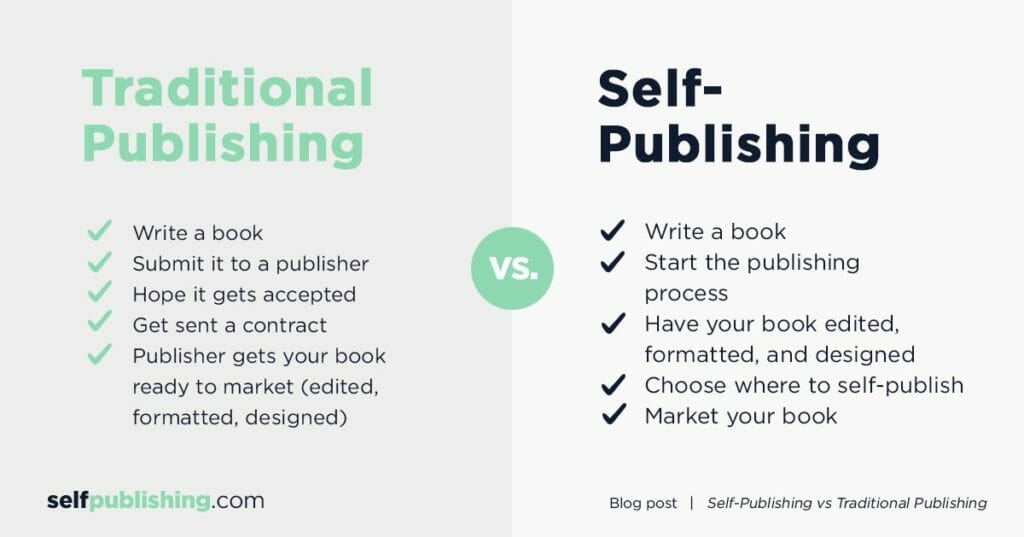
Writing a book: self-publishing vs traditional publishing
Writing your book looks much the same between self-publishing and traditional publishing. The difference is, while in self-publishing you can write whatever you want, in traditional publishing the publisher will get some say in what you are or are not allowed to write.
If you are hoping to traditionally publish your book, you should research the types of books your target publishing house is turning out, including genre, tropes, and tone of voice to ensure your book is something the company will want to publish. Otherwise, you will have a lot of work to do in the editing stage.
Editing a book: self-publishing vs traditional publishing
No matter how you decide to publish, you should throughly self-edit your manuscript before you put it in front of the eyes of others. This will save you a lot of time and pain and ensure that your book is taken much more seriously by editors. After self-editing is where the process differs.
If you are self-publishing your book, you can reach out to independent book editors to see if they would like to work on your book. You can find them through Facebook groups, freelance websites like Upwork or Fiverr, or through self-publishing companies like selfpublishing.com who offer vetted editors for you to work with.
While self-publishing your book, you still have the final say on everything, but remember that the editor has a good understanding of the publishing industry and they have your best interests at heart. If you go this route, you will need to cover the costs of the book editor.
If you want to traditionally publish your book, you need to submit your manuscript to literary agents to hope that someone finds potential in your work. If your manuscript is accepted, the literary agent will submit your work to publishers. This process can take a long time, sometimes years, before you are offered a contract with a publishing company.
Don’t get discouraged! If and when you find the right-fit publishing company for your manuscript, you will work back and forth with the publishing company’s editors. They will have the final say in what does or doesn’t make the cut in your book. In better news, the publishing company will handle all the expenses of the editing process.
Marketing your book: self-publishing vs traditional publishing
If you go with self-publishing vs traditional publishing, you’ll have to do a lot more book marketing work. But don’t let this scare you away. Even if you traditionally publish your book, you have to do a lot of your own marketing if you want to succeed, so book marketing tactics are something that is good to learn no matter what.
Traditional publishers generally do the bare minimum when it comes to book marketing. No matter how you publish its a good idea to have an author website with information about your book, build up your social media following, reach out to book stores for book signing events, and more.
If you are self-publishing your book on Amazon KDP, you can make use of Amazon book ads to try and sell your book as well.
Book royalties: self-publishing vs traditional publishing
Book royalties are one of the areas that really differ between self-publishing vs traditional publishing.
Authors who self-publish typically receive a much higher royalty percentage. For example, platforms like Amazon KDP or IngramSpark offer royalty rates of around 70% for eBooks priced within certain ranges (usually between $2.99 and $9.99), and about 60% for print books (minus printing costs).
Authors who go through traditional publishing typically receive a smaller royalty percentage, ranging from 5% to 15% for physical books and 25% for eBooks (based on the publisher’s standard). This percentage is applied to the book’s list price (not the actual selling price), which can result in lower royalties for the author.
In traditional publishing, authors usually receive an advance against future royalties. This means the publisher pays a lump sum upfront (which could range from a few thousand to several hundred thousand dollars, depending on the book and the author’s profile) before any royalties are earned. The advance is recouped from the book’s royalties until it is fully paid back. If the book doesn’t earn back the advance, the author doesn’t owe the difference, but they won’t earn any additional royalties until the advance is recouped.
| Traditional Royalties | Self-Publishing Royalties |
| 8% for printed books | 60% for printed books |
| 25% for eBooks | 70% for eBooks |
| Advance | No advance |
For a closer look at your earning potential and to compare royalty rates between self-publishing vs traditional publishing, use our Book Royalty Calculator.
Pros & cons of self-publishing vs traditional publishing
When looking at self-publishing vs traditional publishing, each publishing process has its own advantages and disadvantages. As you decide how to publish your book, it’s important to weigh the pros and cons of self-publishing vs traditional publishing.
Each author’s situation is different, so what was the best decision for another author, might not be the best decision for you. As you can see from the steps on how to publish traditionally and through self-publishing, the process is pretty different.
Now it’s time to take a closer look at the advantages and disadvantages of self-publishing vs traditional publishing.
Please keep in mind that what one author might think of as an advantage, you might think of as a disadvantage, and vice versa! Or, you might even find more pros and cons based on your own personal preferences.
Let’s take a close look at the benefits and disadvantages that many authors experience while traditionally publishing a book.
What are the pros and cons of traditional publishing?
If the traditional publishing route sounds like a ton of rejection, you might be wondering why authors choose this path when considering how to publish your book.
In short, it was simply the accepted way to publish for so long. Until recently, many authors didn’t know of any other way to get their work published and into the hands of readers.
Although it’s still extremely difficult to get your book traditionally published today, there are some advantages to going this route.
Pros of traditional publishing:
- No upfront costs from the author. The publisher pays for all of the expenses to get your book published, including editing, formatting, and designing costs.
- Possibly sell more books. Traditional publishers have more industry connections that can help to sell more books. For example, traditionally published books are readily available in retail bookstores.
- Social credibility. It’s validating to have your book accepted by a traditional publisher. It can improve an author’s feelings of self-worth, and it can be considered prestigious. For some authors, this is important.
- Publishing is done for you. You handle the writing and self-editing. The publisher will handle publishing.
Cons of traditional publishing:
- Very competitive. The chances of actually being traditionally published are very slim. In fact, an agent or publisher won’t even consider your work unless you have a social following.
- Lengthy process. If you’re able to get past the gatekeepers and get a book contract, the process is very time-consuming, and can take years for your book to hit the market. Just be aware that you’ll need to spend time querying an agent before publishers will even consider offering you a contract.
- Less creative control. Since the publisher handles the editing, formatting, and designing of your book, you might have less say in how the book actually turns out.
- Lower royalty fees. Because the publisher eats up the costs to publish your book, traditional publishing royalties are often significantly lower.
- Marketing may be up to you. Many publishers provide less support in marketing your book. For instance, marketing may be entirely left up to the author in many cases.
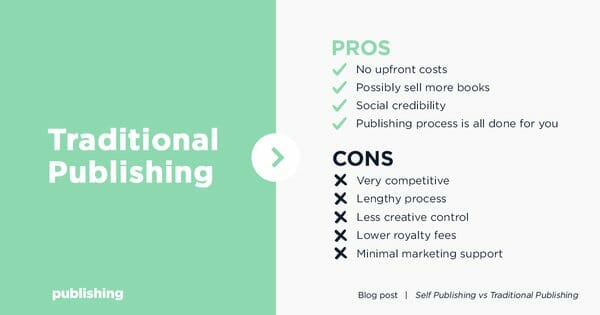
What are the pros and cons of self-publishing?
Now that you understand traditional publishing’s pros and cons, it’s time to weigh the alternative in detail when it comes to how to self-publish a book.
If you’re considering how best to publish your book, it’s important to note the advantages and disadvantages of self-publishing.
Pros of self-publishing:
- No gatekeeper. If you want to write and publish a book, then you can do exactly that. No need to wait for permission.
- A quicker process. It’s all on your timeline, so you can decide when exactly you’d like to write and publish your book, unlike with a traditional book deal.
- Full creative control. You oversee the entire process, and book production is all in your hands. This means that if you have a specific vision for your book, you can execute it!
- Higher royalty rates. Depending on which platform you use to publish your book, the royalty rates are generally higher. For example, if you publish your book on Amazon, royalty rates are as high as 70%!
- Build a skill. Once you learn how to publish your book, the sky’s the limit. To clarify, this means you can keep writing and self-publishing as many books as you want!
- Endless opportunities. Being able to publish your book on your own terms can open up a world of opportunities. Many self-published authors use their books to build industry authority. In fact, some self-published authors even use their books to spring into traditional publishing by getting a book deal!
Cons of self-publishing:
- It’s all at your expense. Self-published authors pay out of pocket for professionals to edit, format, and design their books. There also may be other expenses such as marketing costs.
- You risk selling fewer books. It isn’t standard to have self-published books in any major retailer. With less visibility comes less opportunity to sell a large amount of books. It will be up to you to market your book.
- Less support. It’s up to you to learn how to publish your work. And you’re in charge of the entire book process from start to finish, so everything is up to you. But there is a huge self-publishing community that you can reach out to along with self-publishing companies. You can check out our review of Self-Publishing School to learn more about this avenue.
- Stigma. Self-publishing can sometimes get a bad rap. This is mainly caused by the idea of an oversaturated market and the quality of self-published books. Because the gates are open to literally anyone, there is a higher potential for a self-published book to not be of high quality. This is why it’s crucial to hire professional services like editing.
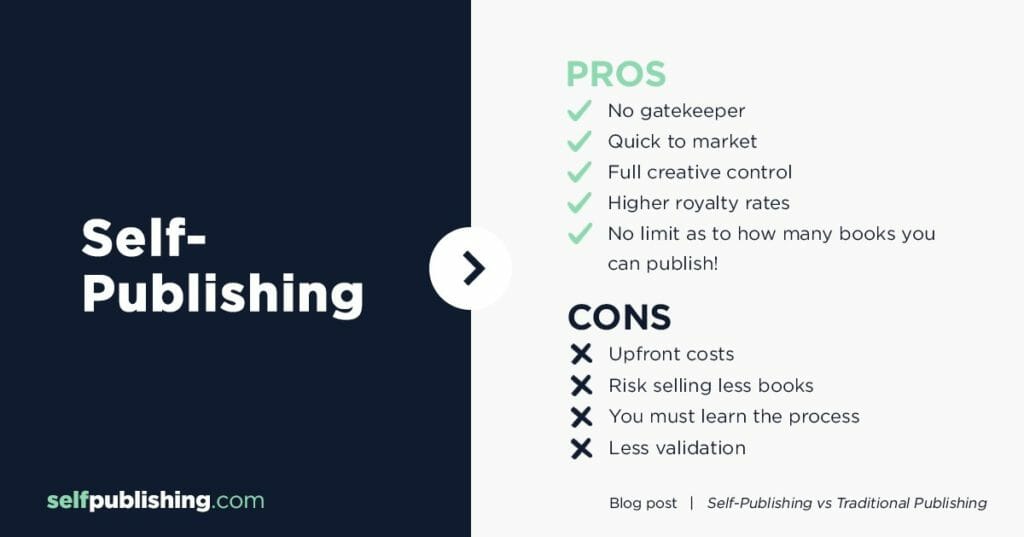
Self-publishing vs traditional publishing – which should you choose?
If you aren’t sure whether to pick self-publishing vs traditional publishing, we have a helpful chart for you to consider:
| Criteria to Consider | Traditional | Self Publish |
| Large social following | X | X |
| Extremely large market | X | X |
| Can handle rejection often | X | |
| No publishing timeline | X | |
| Need the validation | X | |
| Can oversee the entire process yourself | X | |
| Can learn how to publish a book yourself | X | |
| Niche market | X | |
| Specific timeline | X | |
| Budget for editing and design | X | |
| Okay with being the underdog in the publishing world | X |
When you should traditionally publish:
- You have a large social following
- You are writing a book for an extremely large market
- You can handle rejection often
- You have the time and patience for a longer publishing process
- You need social credibility or prestige
When you should self-publish:
- You have the drive and initiative to oversee the entire process yourself
- You are eager to learn how to publish on your own
- You are writing a book geared toward a niche market
- You have a timeline for when you’d like your book published
- You can afford to hire professionals to get your book ready to be published
- You can deal with less validation, and fine being the underdog in the publishing world
- You want to share your book with the world as quickly as possible
Self-publishing vs traditional publishing: make your decision
Achieving your goal to write a book, and making the decision to publish it, is a huge milestone.
As you do research on how to publish a book, we hope this article was informative and helped you find a starting point in considering self-publishing vs traditional publishing.
Whether you’re considering publishing on your own or pursuing a traditional publishing company, learning more about the process will only help – because informed decisions are the best decisions.
If you do decide to self-publish your book, why not reach out to selfpublishing.com? Our team can help you through the entire publishing process, from writing and editing to formatting, book cover design, and marketing. We’ve helped over 8,000 authors create the book of their dreams, and you could be next.





















